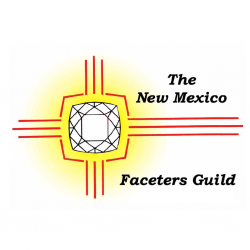While this design looks very simple, it produces a great stone. The pavilion has only a single tier of facets and teaches you how to cut all facets to a single culet meet point followed by creating a level girdle outline. The crown has two tiers and gives you the first exposure to have three different facet ties meet in one location (Girdle, C1 and C2 as well a C1, C2 and table)
Start by cutting opposite facets 04/52 to create a line, then 28/76 to create a cross. When looking down at the culet you should see straight lines all across the stone. This makes it very easy to see under or over cut facets and address this early on vs trying to make 12 facets meet at first.
Once you and your instructor are happy on the first 4 facets, bring the remaining facets to the same center point, being careful to not overcut them. Note if using quartz, there is often one crystal plane that will cut much faster than the rest. Look often at your stone. Once you have found the soft spot, make a note as you will likely encounter the same issue on your crown on the opposite side of the stone.
Minor offsets are ok, you can bring them in on the 600 and 1200 grits progressively. By 1200 grit you want your facets to line up well, just needing minor touch ups during the pre-polish. The more accurate you are, the less time you need to spend on the next finer grit.
As you gain experience, you will learn how close to bring facet meets on the coarser grits.
Once your pavilion facets are done, cut the girdle facets. As you bring in the girdle facets, you should see a level line around your stone. It is usually more accurate to cut to a level girdle after cutting the pavilion to a center point than cutting the girdle to the same height using the machine’s hard stop or angle guide if using a soft stop. Once you have experience, you will get a feel for how hard to push, how your machine sounds and feels and won’t need this method any longer.
Once you have roughed the stone in on the coarsest grit, repeat the above for 600, 1200, 3000 and polish. Your instructor will provide more details on what to look for to ensure you are ready for the next grit. Note that many people do not polish the girdle at this time (some never polish the girdle).
After your stone is transferred, use a girdle facet to align your stone if you don’t have a keyed dop system. Then lightly cut the 1st C1 facet (half a swipe or less) on a stationary lap to see if it is cut evenly left to right; if not, adjust your cheater to ensure a well aligned crown. The angle you use for this does not matter much, anything in the 30-60 degree range works well.
Your instructor may show you other tricks for crown alignment.
Now we follow the same process, depending on the amount of material removal needed, you may be able to skip the 260 grit step and start with 600 grit. If you do use 260 grit, ensure you leave enough girdle to remove the deep 260 grit scratches with your 600 grit lap.
Once the C1 facets are cut, check if the 1st and last facet meet well at the girdle or not; if not, you are not perfectly aligned and may need to adjust the cheater little more; talk to your instructor about what is good enough.
Once you start the C2 facets, keep a little space to the girdle; the final tip comes in very fast and the distance of that tip to the girdle should get smaller with each step, meeting the girdle at your pre-polish step.
Once C1/C2 are polished, your instructor will show you how to align the table adaptor and grind/polish your table. Most machines use a 45o table adaptor and not set the quill to 0 degrees (easy way to mess up your stone or machine).
Keep a close eye how the table moves towards the C1/C2 corners. You may need to lower/raise or cheat left/right to ensure all facets meet the table at the same time.
Once done, your instructor will show you how to remove the stone from the dop and you will have your first stone completed.
Click on a file type below to view the design:
